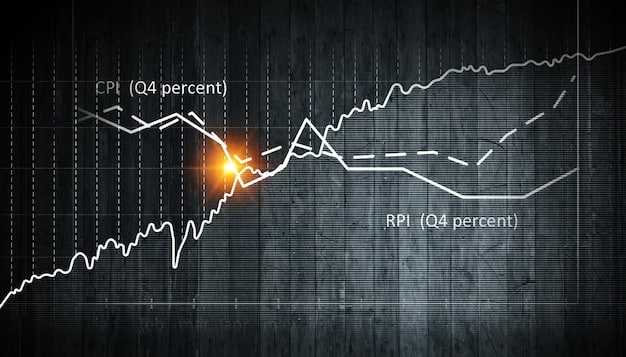Inflation Rate Dips to 3.2%: Impact on US Investments Examined

The recent dip in the US inflation rate to 3.2% signifies a potential shift in the economic landscape, influencing interest rate expectations, consumer purchasing power, and impacting various investment categories such as stocks, bonds, real estate, and commodities, thereby requiring investors to reassess their strategies.
The latest economic data reveals a noteworthy development: the US inflation rate has dipped to 3.2%. This news, while seemingly a subtle shift, carries significant weight, especially for anyone navigating the complex world of personal finance and investments. Understanding what this specific percentage means, and more importantly, how it could shape your financial decisions, is crucial in today’s dynamic market.
Understanding the Current Inflationary Landscape
The recent announcement that the US inflation rate has fallen to 3.2% signals a potential turning point in economic conditions. For many, inflation has been a persistent concern, eroding purchasing power and creating uncertainty in financial planning. This new figure, while still above the Federal Reserve’s long-term target of 2%, suggests that the aggressive monetary policies implemented over the past year might be starting to yield their intended results.
Inflation, at its core, reflects the rate at which the general level of prices for goods and services is rising, and, consequently, the purchasing power of currency is falling. When this rate decreases, as it has now, it can offer a glimmer of hope for consumers and investors alike. However, it’s not simply a matter of “lower is always better.” The context of this dip, including its causes and potential duration, is vital for a comprehensive understanding of its implications.
What Drives Inflation?
Understanding the forces behind inflation is key to interpreting its movements. Several factors can contribute to rising prices, and their interplay determines the overall inflationary environment.
- Demand-Pull Inflation: Occurs when aggregate demand in an economy outpaces aggregate supply, leading to upward pressure on prices.
- Cost-Push Inflation: Results from an increase in the cost of production, such as rising wages or raw material prices, which businesses pass on to consumers.
- Built-In Inflation: Often a result of adaptive expectations, where workers seek higher wages to maintain their living standards and businesses raise prices to cover these costs, creating a wage-price spiral.
The recent inflationary cycle has been a complex mix of these factors, exacerbated by global supply chain disruptions, shifts in consumer demand post-pandemic, and geopolitical events. The current dip to 3.2% could indicate that some of these pressures are easing, or that the Federal Reserve’s actions, such as interest rate hikes, are effectively curbing demand.
The Federal Reserve’s primary tool for managing inflation is monetary policy, specifically adjusting the federal funds rate. By raising interest rates, the Fed aims to cool down the economy, making borrowing more expensive and thereby reducing consumer spending and business investment. Conversely, lower rates stimulate economic activity. The 3.2% figure will undoubtedly be a key metric the Fed considers in its upcoming policy decisions.
While a lower inflation rate is generally welcome news, investors must look beyond the headline number. It’s essential to analyze what components of inflation are decelerating and whether this trend is sustainable. A reduction primarily driven by volatile components, like energy, might provide less long-term comfort than a broad-based cooling across various sectors of the economy.
This economic data release compels investors to revisit their assumptions about the future. It’s not just about the current rate, but what this rate implies for future monetary policy, economic growth, and the overall financial landscape. Prudent investors will seek to understand these nuances to adapt their strategies effectively.

The Federal Reserve’s Stance and Future Policy
The Federal Reserve closely monitors inflation data, among other economic indicators, to guide its monetary policy decisions. The dip in the inflation rate to 3.2% undoubtedly provides the Fed with valuable information, potentially influencing the trajectory of interest rates and quantitative easing measures. Understanding the Fed’s potential reactions is paramount for investors, as these decisions ripple through all asset classes.
Historically, the Fed has a dual mandate: to achieve maximum employment and maintain price stability. When inflation runs high, the Fed typically implements contractionary policies, such as raising the federal funds rate, to cool down the economy and bring prices under control. Conversely, during periods of economic slowdown or low inflation, it may adopt expansionary policies like lowering rates to stimulate growth.
Impact on Interest Rate Expectations
A lower inflation rate often translates into revised expectations for future interest rate hikes. If inflation continues its downward trend, the Fed might feel less pressure to raise rates aggressively, or even consider a pause or reduction in hikes. This shift in sentiment can have a profound impact on various parts of the financial market.
- Reduced Likelihood of Aggressive Hikes: If inflation is seen as moderating, the Fed might scale back the pace, or even the magnitude, of future rate increases.
- Potential for a “Soft Landing”: A gradual decrease in inflation without triggering a recession is often termed a “soft landing,” a highly desired outcome that the Fed aims for.
- Market Reaction: Financial markets often react swiftly to changes in Fed sentiment, with bond yields, stock prices, and currency values all potentially adjusting in response.
Investors should pay close attention to the language used by Fed officials in their public statements and minutes from Federal Open Market Committee (FOMC) meetings. These communications offer crucial clues about their assessment of the economy and their policy intentions. Any indication that the Fed is softening its hawkish stance could be interpreted as a positive signal for growth-oriented assets.
The relationship between inflation and interest rates is complex. While lower inflation might reduce the need for higher rates, the Fed will also consider other factors, such as the labor market, global economic conditions, and geopolitical risks. Therefore, a single data point, even one as significant as a dip in inflation, doesn’t guarantee a complete shift in policy. It’s part of a larger puzzle.
Moreover, the concept of “real interest rates” (nominal interest rate minus inflation rate) becomes more relevant. If nominal rates hold steady or decline slightly while inflation falls, real rates effectively rise. This can affect borrowing costs and the attractiveness of different investments. Investors should be prepared for varying scenarios regarding the Fed’s future actions, as unexpected economic data or events could always alter its course.
The Federal Reserve’s primary objective remains long-term price stability. While a 3.2% inflation rate is a positive step, it’s still some distance from their target. Therefore, while a moderation in hikes may be possible, it’s unlikely the Fed will abandon vigilance until inflation is firmly under control and closer to the 2% target. Continuous monitoring of these developments is essential for strategic investment decisions.
Impact on Different Investment Categories
The deceleration of inflation to 3.2% has far-reaching implications for nearly every investment class. Investors must re-evaluate their portfolios through the lens of this new economic reality, considering how stocks, bonds, real estate, and commodities might perform in an environment of potentially moderating price pressures and altered central bank policies. Each asset class reacts differently to inflationary shifts.
Stocks: Growth vs. Value and Sector Performance
The stock market’s reaction to easing inflation is often nuanced. Generally, lower inflation can be a positive for equities, as it might reduce the likelihood of aggressive rate hikes, which tend to dampen corporate profits and economic growth. However, the impact varies significantly across different types of stocks.
- Growth Stocks: Companies with high growth potential, often in technology, tend to benefit from lower interest rates as their future earnings are discounted at a lower rate, making them more valuable today.
- Value Stocks: Companies that are typically more established and less sensitive to interest rate changes might see stable performance, but their growth prospects could be less impacted than growth stocks.
- Sectoral Impact: Certain sectors, like consumer discretionary, might see a boost if consumers regain purchasing power. On the other hand, sectors that thrive on higher inflation, like energy or materials, might face headwinds if commodity prices soften.
A lower inflation rate could also improve corporate profit margins if input costs ease while consumer demand remains robust. This scenario could lead to stronger earnings reports and provide support for stock valuations. However, if the dip in inflation signals a broader economic slowdown, overall corporate earnings could suffer, regardless of the sector.
Bonds: Yields, Duration, and Credit Risk
Bonds are particularly sensitive to inflation and interest rate expectations. When inflation cools, bonds generally become more attractive, especially fixed-income securities.
A downward trend in inflation often leads to a decrease in bond yields, as future inflation expectations are baked into current yields. Investors may find existing fixed-rate bonds more appealing if newly issued bonds offer lower interest payments. This scenario typically benefits longer-duration bonds more, as their prices are more sensitive to changes in interest rates.
Regarding credit risk, in a moderating inflation environment, the risk of defaults might decrease if the broader economic outlook appears more stable. However, investors should still scrutinize the creditworthiness of individual issuers, as specific corporate or government debt situations can always present unique challenges, irrespective of the general economic climate.
Real Estate and Commodities
Real estate and commodities also react distinctly to inflation changes. Real estate is often seen as a hedge against inflation, as property values and rents tend to rise with prices. However, a significant slowdown in inflation, coupled with higher interest rates, can affect mortgage affordability and dampen demand, potentially cooling the housing market.
Commodities, such as oil, gold, and agricultural products, have traditionally been viewed as inflation hedges. Their prices tend to increase when inflation is high. If inflation continues to decelerate, some commodity prices might stabilize or even decline, impacting portfolios heavily weighted in these assets. Gold, for instance, often performs well during periods of high inflation or economic uncertainty, but its appeal might wane if inflation fears subside and real interest rates rise.
In summary, the 3.2% inflation rate necessitates a re-evaluation of portfolio allocations. Diversification remains a critical strategy, allowing investors to mitigate risks and capitalize on opportunities across various asset classes as the economic landscape evolves.
Consumer Spending and Purchasing Power
The recent dip in the US inflation rate to 3.2% holds significant implications for the average consumer, directly influencing their spending habits and overall purchasing power. For months, households have grappled with elevated costs for everyday goods and services, leading to strained budgets and difficult financial decisions. A moderation in inflation could offer a much-needed reprieve, but the extent of this relief depends on several factors.
When inflation is high, the same amount of money buys fewer goods and services, effectively reducing purchasing power. This erosion of value forces consumers to prioritize essential spending, often cutting back on discretionary items or dipping into savings. A lower inflation rate means that prices are still rising, but at a slower pace, which can gradually restore some of that lost purchasing power over time.
Psychological Impact on Consumers
Beyond the direct financial implications, inflation has a considerable psychological effect on consumers. Persistent price increases can lead to anxiety about future living costs and discourage long-term financial planning. A slowdown in this trend can foster greater confidence, encouraging consumers to feel more secure about their economic well-being.
- Increased Confidence: Consumers may feel more optimistic about their financial future if prices stable, potentially leading to more willingness to spend on non-essential goods.
- Budget Relief: Slower price increases mean household budgets stretch further, reducing the pressure on families to make difficult trade-offs.
- Savings Impact: While higher inflation erodes the value of savings, a more stable inflationary environment, especially if coupled with competitive interest rates on savings accounts, can make saving more attractive.
However, it’s important to differentiate between disinflation (a slowing in the rate of inflation) and deflation (a decrease in the general price level). While disinflation is generally positive, severe deflation can signal a broader economic downturn and lead to deferred spending, as consumers wait for prices to fall further. The current situation is one of disinflation, which is typically viewed favorably.
The impact on consumer spending will also depend on wage growth. If wages keep pace with or exceed the rate of inflation, then real wages are increasing, allowing consumers to afford more. If wage growth lags behind, even a moderating inflation rate might not fully alleviate financial pressures.
For businesses, a more predictable inflation environment allows for better planning and pricing strategies. They might face less pressure to constantly adjust prices and wages, which can lead to more stable operational costs. This stability can, in turn, be passed on to consumers through more consistent pricing.
Ultimately, the dip to 3.2% offers a chance for consumers to regain some financial footing. It provides an opportunity to re-evaluate household budgets, perhaps increase savings, or even consider larger purchases that might have been postponed due to inflationary concerns. This return of purchasing power, even if gradual, is a key component of a healthy and stable economy.
Sector-Specific Opportunities and Challenges
The recent moderation of the inflation rate to 3.2% creates a mixed bag of opportunities and challenges across various economic sectors. While some industries might find relief and avenues for growth, others could face new headwinds. Investors keen on capitalizing on this evolving landscape must understand these sector-specific dynamics.
Sectors that have been particularly vulnerable to high inflation, such as consumer discretionary goods and services, might experience a rebound. As consumers potentially regain purchasing power and confidence, they may be more willing to spend on non-essential items, benefiting retailers, travel companies, and entertainment providers. This shift could lead to increased revenue and improved profitability for businesses in these areas.
Technology and Growth-Oriented Sectors
The technology sector often thrives in environments of lower inflation and stable interest rates. Many tech companies rely on significant future earnings to justify their current valuations, and these valuations are particularly sensitive to the discount rate used to calculate their present value. A lower inflation rate, potentially leading to stable or lower interest rates, can make future earnings look more attractive, boosting technology stock prices.
- Innovation Investment: Companies in this sector may find it easier to secure funding for research and development, fostering innovation and long-term growth.
- Subscription-Based Models: Businesses with recurring revenue models tend to be more resilient to economic fluctuations, and stability in consumer spending further enhances their appeal.
- Valuation Rebound: After a period where higher interest rates pressured tech valuations, a cooling inflation rate could spark a rebound for many growth stocks.
However, it is crucial to remember that the tech sector is not monolithic. Some areas, like hardware manufacturing, might still face supply chain challenges, while others, like software and services, could see more immediate benefits. Investors need to be discerning within the sector.
Energy, Materials, and Financials
Sectors that have historically benefited from high inflation, such as energy and basic materials, might face new challenges. If the slowdown in inflation translates into softer commodity prices, companies in oil and gas, mining, and other resource-intensive industries could see their revenue streams diminish. Their profitability often correlates with rising commodity costs, so a reversal could impact their performance negatively.
The financial sector, including banks and insurance companies, operates in a complex relationship with interest rates and inflation. While a rapid increase in interest rates can boost net interest margins for banks, excessive inflation can also lead to loan defaults. A more stable, disinflationary environment with gradual rate adjustments could be beneficial, allowing for managed growth and reduced default risks. However, if interest rates fall too quickly, it might compress their lending margins.
The healthcare and utilities sectors are typically considered more defensive, meaning they tend to perform relatively consistently regardless of economic cycles. While they may not offer the explosive growth potential of tech, their stability can be attractive in transitional periods. They are less sensitive to inflation fluctuations due to the essential nature of their services.
Ultimately, investors should adopt a diversified approach, carefully researching individual companies and evaluating their resilience and growth potential within their respective sectors, rather than making broad assumptions based solely on the inflation rate.
Strategies for Investors in a 3.2% Inflation Environment
In an economic landscape where the inflation rate has moderated to 3.2%, investors are faced with both new challenges and compelling opportunities. Crafting an effective investment strategy in this environment requires a thoughtful re-evaluation of current holdings and a forward-looking perspective on asset allocation. The key is to adapt to evolving market signals rather than reacting impulsively.
One primary consideration is the potential shift in monetary policy. If the Federal Reserve continues to ease its hawkish stance due to declining inflation, it could lead to more stable or even lower interest rates in the future. This scenario typically favors growth-oriented investments and can make fixed-income assets more attractive if their yields remain competitive against a backdrop of slower price increases.
Rebalancing Your Portfolio
Rebalancing is more than just buying low and selling high; it’s about realigning your portfolio with your risk tolerance and financial goals in light of new economic data. With inflation moderating, some asset classes that struggled during periods of high inflation might now offer better prospects, while those that thrived as inflation hedges might see their returns diminish.
- Review Asset Allocation: Assess if your current mix of stocks, bonds, and other assets still aligns with your long-term objectives and risk profile.
- Consider Growth vs. Value: With potentially lower interest rate pressure, growth stocks might become more appealing, necessitating a balanced exposure.
- Fixed Income Adjustments: Evaluate the duration of your bond holdings; longer-duration bonds might perform better if rates stabilize or decline.
Diversification remains paramount. Spreading investments across various asset classes, sectors, and geographies helps mitigate risk and capture opportunities in different market conditions. A portfolio that performed well during peak inflation might not be optimal as inflation cools, emphasizing the need for flexibility.
Investors should also pay close attention to corporate earnings reports and economic indicators beyond just inflation. Unemployment rates, consumer spending data, and manufacturing output can provide additional clues about the economy’s health and future direction. These data points collectively inform the broader investment environment.
For those considering real estate, a moderating inflation rate combined with resilient economic activity could support the market, provided interest rates don’t rise significantly to deter buyers. However, individual market conditions and property types will still play a crucial role. Similarly, in commodities, a shift away from high inflation might mean less speculative demand, requiring a focus on fundamental supply and demand dynamics.
Finally, maintaining a long-term perspective is essential. Market fluctuations are inevitable, and reacting to every economic data point can lead to suboptimal decisions. Instead, investors should use this new information to refine their strategy, focusing on quality investments that are well-positioned for sustainable growth and stability, regardless of short-term volatility. Engaging with a financial advisor can also provide tailored guidance.
Potential Risks and Headwinds Ahead
While the dip in the inflation rate to 3.2% is a welcome development, it would be imprudent for investors to assume a clear path forward. The economic landscape remains fraught with potential risks and headwinds that could alter the trajectory of inflation, interest rates, and market performance. A nuanced understanding of these challenges is crucial for building resilient investment portfolios.
One significant risk is the possibility that inflation could re-accelerate. Despite the recent dip, underlying inflationary pressures might still be simmering beneath the surface. Factors such as unforeseen supply chain disruptions, renewed geopolitical tensions impacting energy or food prices, or even a sudden surge in consumer demand could push prices higher once again. The Federal Reserve would then be compelled to revert to more aggressive monetary tightening, which could negatively impact asset valuations.
Stubborn Core Inflation
Investors should distinguish between headline inflation (which includes volatile components like food and energy) and core inflation (which excludes them). While headline inflation has dipped, core inflation might prove to be more stubborn, indicating persistent demand or wage pressures. If core inflation remains elevated, the Fed might still maintain a hawkish stance, even with a seemingly lower headline number.
- Wage-Price Spiral: Sustained wage growth without corresponding productivity gains can fuel a wage-price spiral, making inflation harder to tame.
- Services Inflation: The services sector often experiences stickier inflation due to labor costs, and this component can be harder for monetary policy to influence quickly.
- Global Factors: External factors like currency fluctuations, trade policies, and economic slowdowns in other major economies can indirectly impact US inflation and investment performance.
Another concern is the risk of a recession. While a “soft landing” is the Federal Reserve’s goal – bringing inflation down without triggering a severe economic downturn – this is a delicate balancing act. Over-tightening monetary policy could stifle economic growth, leading to job losses and reduced corporate earnings. A recession would naturally create challenges across nearly all investment categories, particularly for equities and riskier assets.
Geopolitical instability also presents an ongoing headwind. Conflicts, trade wars, or political unrest in key regions can disrupt global supply chains, drive up commodity prices, and create uncertainty that deters investment. Such events are often unpredictable and can quickly erode investor confidence, leading to market volatility.
Furthermore, the long-term impact of national debt and fiscal policies should not be overlooked. While monetary policy addresses short-term inflation, persistent government deficits can, over time, contribute to inflationary pressures and raise questions about long-term fiscal stability, potentially impacting bond markets and the value of the dollar.
Therefore, even with a seemingly positive inflation report, investors need to maintain a vigilant and diversified approach. Stress-testing portfolios against various adverse scenarios and remaining flexible in strategy adjustments will be key to navigating potential economic headwinds successfully.
Long-Term Outlook and Planning
The current dip in the US inflation rate to 3.2% provides a valuable data point, but long-term investment planning requires looking beyond immediate economic headlines. While short-term adjustments to your portfolio might be necessary, a robust long-term strategy focuses on overarching financial goals, risk tolerance, and consistent execution, irrespective of transient market movements. Understanding the broader economic cycles and structural changes is pivotal.
For long-term investors, the goal is not to perfectly time the market or react to every inflation report, but rather to build a portfolio that can withstand various economic conditions and consistently generate returns over decades. This involves setting clear objectives, whether for retirement, education, or wealth accumulation, and sticking to a disciplined investment approach.
Emphasizing Diversification and Quality
Diversification remains the cornerstone of long-term investment success. Spreading your investments across different asset classes (stocks, bonds, real estate, alternatives), sectors, and geographic regions helps mitigate risk. When one asset class underperforms, another might compensate, smoothing out overall portfolio returns.
- Asset Allocation: Regularly review and rebalance your asset allocation to ensure it aligns with your evolving risk profile and long-term goals.
- Quality Investments: Focus on investing in high-quality companies with strong financials, competitive advantages, and proven management teams, as these tend to be more resilient during economic cycles.
- Global Exposure: Don’t limit your portfolio to domestic markets; international diversification can provide access to different growth drivers and reduce country-specific risks.
Even with moderating inflation, investors should consider investments that offer protection against potential future inflationary surges. This could include real estate, certain commodities (like gold in some scenarios), or Treasury Inflation-Protected Securities (TIPS), which adjust their principal value in line with inflation.
Another crucial aspect of long-term planning is understanding the power of compounding. By consistently investing over time, even modest returns can accumulate significantly as earnings generate further earnings. This effect is most potent when inflation is under control, as it preserves the real value of those compounded returns.
Emotional discipline is perhaps the most challenging aspect of long-term investing. Resisting the urge to panic during market downturns or chase fads during booms is essential. Stick to your investment plan, avoid frequent trading based on news headlines, and remember that market volatility is a normal part of the investment landscape.
Finally, regularly review your financial plan with a qualified advisor. They can help you assess your situation, make informed decisions, and ensure your portfolio remains aligned with your long-term aspirations. The 3.2% inflation rate is a piece of the puzzle, not the entire picture; a holistic and patient approach will always yield the best results for the long-term investor.
| Key Point | Brief Description |
|---|---|
| 📊 Inflation Dip Context | The 3.2% rate suggests easing price pressures, potentially influenced by Fed policies and supply chain improvements. |
| 🏦 Fed Policy Outlook | May lead to less aggressive interest rate hikes or a pause, influencing bond yields and market sentiment. |
| 💰 Investment Impact | Changes stock valuations (especially growth stocks), bond attractiveness, and commodity/real estate hedging roles. |
| 🛡️ Investor Strategy | Calls for portfolio rebalancing, diversification, and long-term planning amidst potential economic shifts. |
Frequently Asked Questions About Inflation and Your Investments
A 3.2% inflation rate means that prices are still rising, but at a slower pace than before. For your savings, it implies that the purchasing power of your money is eroding at 3.2% per year. If your savings account offers an interest rate below 3.2%, your money is effectively losing value in real terms.
The dip to 3.2% could signal to the Federal Reserve that its previous monetary tightening policies are working. This might lead them to slow the pace of future interest rate hikes, or even consider a pause, to avoid over-tightening the economy and potentially causing a recession. However, they will weigh this alongside other economic indicators.
Yes, often. Growth stocks, particularly in the technology sector, tend to perform better when inflation is moderating. This is because their future earnings streams are discounted at potentially lower interest rates, making their present valuations more appealing. Lower inflation also reduces the pressure for aggressive rate hikes, which can benefit growth-oriented companies.
With inflation moderating, the attractiveness of bonds generally increases. If the Federal Reserve reduces or pauses rate hikes, bond yields might stabilize or even decrease, which typically leads to an increase in bond prices, especially for longer-duration bonds. Reviewing your bond duration and considering high-quality issues could be prudent.
Despite the dip, risks like a potential re-acceleration of inflation due to external factors, the possibility of a recession if the Fed over-tightens, and ongoing geopolitical instability remain. Investors should also monitor core inflation, which might be stickier, to get a comprehensive view of underlying price pressures and adapt accordingly.
Conclusion
The recent report indicating a dip in the US inflation rate to 3.2% marks a significant development in the ongoing economic narrative. While providing a measure of relief from persistently high price pressures, this new figure necessitates a careful re-evaluation of investment strategies across the board. It signals a potential shift in the Federal Reserve’s monetary policy, possibly leading to less aggressive interest rate hikes and influencing the attractiveness of various asset classes. From stocks and bonds to real estate and commodities, each segment of the market reacts differently to such changes, demanding an informed and adaptive approach from investors. Understanding the nuances of disinflation, recognizing potential headwinds, and prioritizing diversification remain critical for navigating this evolving financial landscape. Ultimately, successful investment in this environment will stem from a blend of informed decision-making, meticulous portfolio management, and a steadfast commitment to long-term financial goals.





